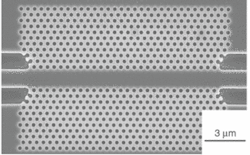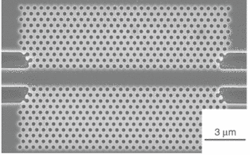Microscope sees slow light in waveguide
A European collaboration has found a new way of slowing down light and has demonstrated it by making a movie of pulses traveling through the device. The group’s new technique uses a photonic-crystal waveguide to slow the light and a phase-sensitive near-field scanning optical microscope (PS-NSOM) to observe it.1 The observations have shown pulses traveling at about one-thousandth of the normal speed of light. The breakthrough could accelerate the development of all-optical devices.
The partnership that undertook the work includes scientists from the University of Twente (Enschede, The Netherlands), the Fundamental Research on Matter (FOM) Institute for Atomic and Molecular Physics (Utrecht, The Netherlands), Ghent University (Ghent, Belgium), and the University of St. Andrews (St. Andrews, Scotland).
The photonic-crystal-waveguide structure (PhCW) was designed at St. Andrews by Tim Karle and Thomas Krauss. The structures were fabricated on a silicon-on-insulator wafer with a 220-nm-thick silicon waveguide layer on top of a 1-μm-thick silicon dioxide cladding. Holes were arranged in a hexagonal array spaced by about 460 nm and with a hole radius of 130 nm (see Fig. 1). Three rows of missing holes form the PhCW, which can be easily integrated with other optical-circuit elements such as fibers, and can be produced to operate at various wavelengths.
Henkjan Gersen and Kobus Kuipers from the University of Twente and FOM built the PS-NSOM. Seeing inside a PhCW has proved tricky before. The guided modes are evanescent in air, so they can’t be observed with far-field techniques; furthermore, diffraction limits what can be done by looking at them directly and close up. The new system uses a subwavelength probe-an aperture in a metal-coated fiber-which is brought into the evanescent field close to a sample surface. The collected light interferes with a frequency-shifted reference beam, allowing the local field amplitude and phase to be measured. The probe is raster-scanned across the PhCW at less than 10 nm above its surface. When there are ultrashort pulses in the waveguide, this technique allows direct visualization of what is happening to the light. The PS-NSOM can produce images and movies with nanoscale resolution that show the propagation of the slowed light pulses in the waveguide.
Seeing is believing
The initial work used 120-fs pulses at a wavelength of 1.3 μm; images captured by the PS-NSOM showed that under the right conditions the pulses were in a guided mode with an extremely slow velocity and very large group-velocity dispersion, traveling at about one-thousandth of the speed of light in vacuum (see Fig. 2). The group concludes that, although not easy to create, specific modes for excitation can be generated by careful design of mode converters and couplers, which could lead to very efficient coupling to slow modes. These huge trapping times, seen without the use of a cavity, should open up new schemes for dispersion and time control of optical signals in photonic crystals.
“For me, there are several reasons to be excited about our results,” says Kuipers. “The first is that capturing a light ray has tickled my imagination for many years now and to actually do so is great. Moreover, to see it happening rather than inferring it is very special-seeing is believing. Second, now that we have shown that we can slow down light in a photonic-crystal waveguide, all the flexibility that these two-dimensional crystals offer can be brought to bear to make it useful. One can think of integrated optical-delay lines for managing optical traffic in telecommunication, but also of new lasers. Another exciting application lies in biosensing: by slowing down light, its interaction with its surroundings is increased, potentially allowing the detection of trace amounts of biomolecules.”
Kuipers would also like to slow down surface plasmons in so-called plasmonic crystals. “Slowing these quasi-particles should lead to huge local field enhancements that I aim to exploit in new nonlinear optics at the nanoscale,” he says.
REFERENCE
1. H. Gersen et al., Phys. Rev. Lett. 94, 073903 (2005).


